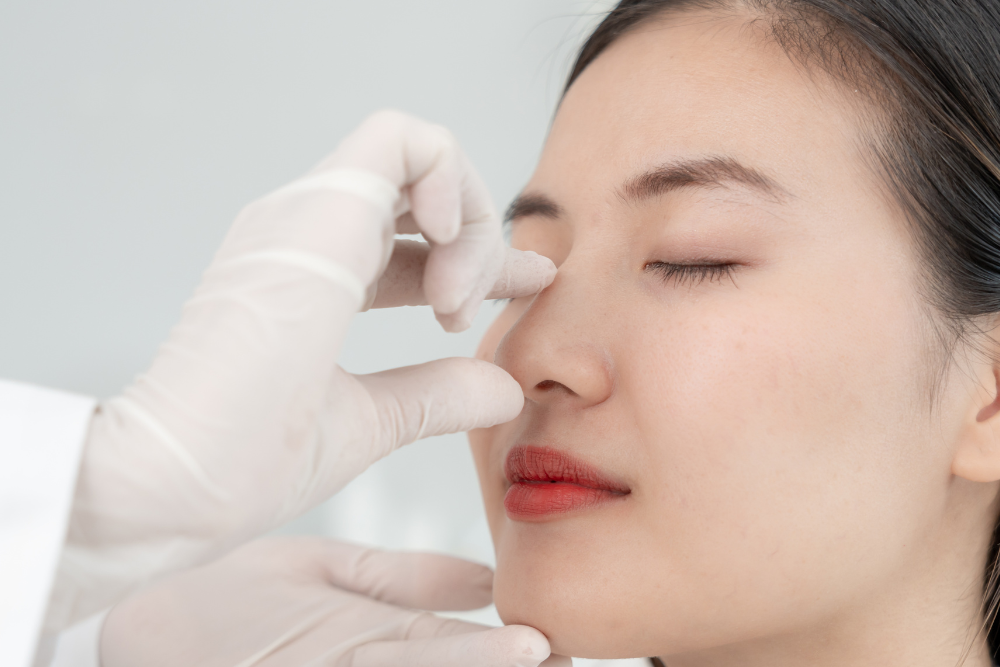





Delivering Excellence in Facial Plastic Surgery
Precision. Passion. Perfection
Safe, Artful Transformations for Your Face
Comprehensive ENT Care for Kids and Adults.
Your Family's ENT Care, Fully Addressed
Rhinoplasty: Enhancing Nasal Aesthetics
and Function.
NASAL OBSTRUCTION IN SINGAPORE
UNDERSTANDING NASAL OBSTRUCTION: CAUSES AND MANAGEMENT STRATEGIES
Nasal obstruction, commonly referred to as a stuffy nose, can be more than a mere annoyance; for some, it’s a daily struggle that affects quality of life. This blog post delves into the potential causes of nasal obstruction and outlines various management strategies that can help sufferers breathe easier.
CAUSES OF NASAL OBSTRUCTION
Nasal obstruction can stem from a variety of causes, and pinpointing the exact reason is crucial for effective management. Here are some common culprits:
STRUCTURAL ABNORMALITIES
- Deviated Septum: A displacement of the nasal septum that can significantly block airflow in one or both nostrils.
- Nasal Valve Stenosis or Collapse: Nasal valve areas are the narrowest parts of the nasal passages, any narrowing due to structural abnormality or collapse on inspiration due to weakness of the relevant structures can lead to difficulty with breathing.
- Enlarged Turbinates: These structures can swell due to allergies or irritants, reducing nasal passage size.
- Nasal Polyps: Noncancerous growths in the nasal or sinus passages can cause obstruction and are often associated with chronic inflammation.
- Choanal Atresia: A congenital condition where tissue blocks the nasal passage, usually identified shortly after birth.
INFLAMMATORY CONDITIONS
- Allergic Rhinitis: An allergic response to airborne substances like pollen, causing nasal passage inflammation.
- Sinusitis: Infection or inflammation of the sinus cavities can lead to congestion and blockage.
- Rhinitis Medicamentosa: Overuse of nasal decongestant sprays can lead to rebound congestion and chronic obstruction.
INFECTIOUS CAUSES
- Common Colds and Flu: Viral infections are a leading cause of temporary nasal obstruction.
- Upper Respiratory Infections: These can lead to swelling and blockage of the nasal passages.
OTHER CAUSES
- Tumours: Though less common, benign, or malignant growths can cause nasal blockages.
- Foreign Bodies: Especially in children, objects inserted into the nose can cause obstruction.
NASAL OBSTRUCTION MANAGEMENT SINGAPORE
The management of nasal obstruction often depends on its cause. Here are some general strategies and treatments:
Home Remedies
- Steam Inhalation: Using a humidifier or inhaling steam can help moisten the nasal passages and relieve congestion.
- Hydration: Drinking plenty of fluids can thin mucus, making it easier to expel.
- Saline Sprays: These can help to moisten the nasal passages and relieve mild congestion.
Medications
- Decongestants: These drugs reduce nasal passage swelling but should be used cautiously and for short periods.
- Antihistamines: Useful in managing allergies, they can reduce nasal swelling and secretions.
- Nasal Steroid Sprays: These can reduce inflammation and treat symptoms of allergic rhinitis and sinusitis.
Surgical Options
- Septoplasty: A procedure to correct a deviated septum.
Read More About Paediatric Septoplasty & Septorhinoplasty >>>
- Septoplasty: A procedure to correct a deviated septum.
- Turbinate Reduction: Surgery to reduce the size of the turbinates.
- Functional Rhinoplasty: Surgery to alter the structure of the nose to improve breathing. This includes surgery to correct any collapse of the nasal valves.
- Polypectomy: The removal of nasal polyps.
- Tumour removal: The removal of nasal tumours.
LIFESTYLE ADJUSTMENTS
- Allergen Avoidance: Identifying and avoiding allergens can reduce nasal inflammation.
- Air Filters: Using HEPA filters can help remove allergens from the air in your home.
- Smoking Cessation: Smoking is a significant irritant that can exacerbate nasal obstruction.
WHEN TO SEEK MEDICAL ATTENTION
While many causes of nasal obstruction are benign and temporary, persistent or severe symptoms warrant professional evaluation. If you experience any of the following, consult a healthcare provider:
- Obstruction not responding to over-the-counter treatments.
- Nasal symptoms of blocked nose, runny nose, excessive sneezing, worsening nasal blockage with exercise, facial pain, or headaches.
- Signs of a severe infection such as fever, facial pain, or green nasal discharge.
- Breathing difficulty causing sleep disturbance or impacting daily activities.
- Symptoms lasting more than 10 days or getting progressively worse
BREATHE NEW LIFE WITH DR SANDEEP'S EXPERTISE
Suffering from nasal obstruction can feel like an endless battle, but with Dr Sandeep’s dual Fellowship Training in Facial Plastic Surgery and Rhinology, you have an ally. His extensive knowledge in both the disciplines positions him to craft tailored solutions that consider all aspects of your nasal health. Whether your obstruction requires medical management, surgical intervention, or both, Dr Sandeep’s expertise is your gateway to relief. Schedule your consultation now and start the journey to breathe freely with confidence.
READ MY BLOG ON ALLERGIES vs SINUSITIS >>>
READ MY BLOG – UNDERSTANDING ALLERGY MEDICATIONS HERE >>>
Explore our other treatments:
Snoring and Obstructive Sleep Apnoea, Allergy and Sinus Infections, Nasal Obstruction, Nose Bleeds, Ear Wax, Ear Infection, Tinnitus, Hearing Loss, Dizziness and Balance Problems, Tonsil and Adenoid Issues, Thyroid Nodules, Salivary Gland Tumours, Voice and Swallowing Disorders.


